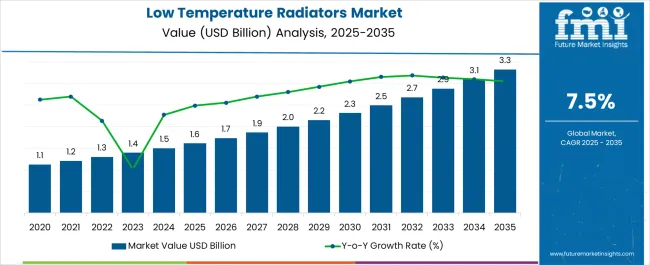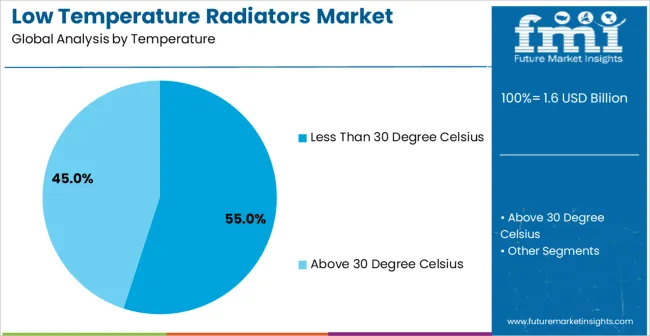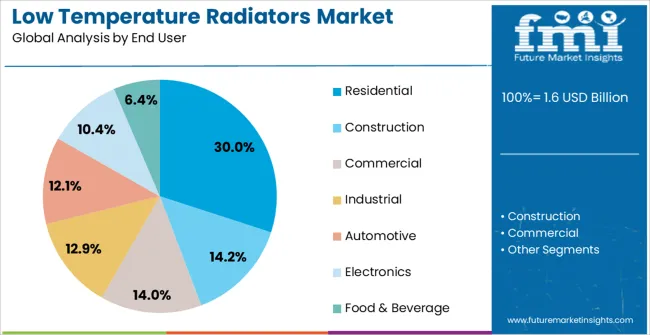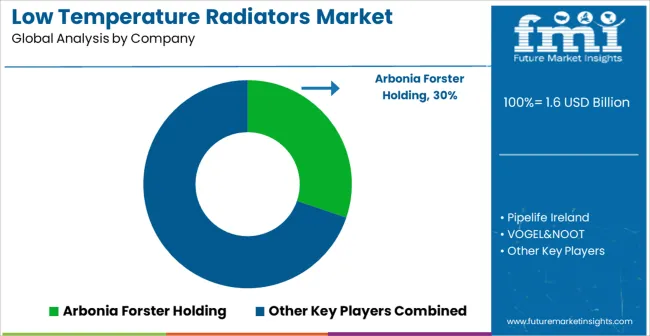The Low Temperature Radiators Market is estimated to be valued at USD 1.6 billion in 2025 and is projected to reach USD 3.3 billion by 2035, registering a compound annual growth rate (CAGR) of 7.5% over the forecast period.

| Metric | Value |
|---|---|
| Low Temperature Radiators Market Estimated Value in (2025 E) | USD 1.6 billion |
| Low Temperature Radiators Market Forecast Value in (2035 F) | USD 3.3 billion |
| Forecast CAGR (2025 to 2035) | 7.5% |
The Low Temperature Radiators market is experiencing significant growth due to the increasing demand for energy-efficient and sustainable heating solutions across residential and commercial sectors. The future outlook for this market is shaped by the rising adoption of low-temperature heating systems, which provide enhanced thermal comfort while reducing energy consumption and environmental impact. Growing awareness about climate change and energy conservation is encouraging the installation of radiators that operate efficiently at lower temperatures.
Continuous advancements in radiator technology, such as improved heat transfer and integration with modern smart home systems, are further driving market expansion. The market is also supported by government incentives and building codes promoting energy-efficient heating solutions, particularly in residential developments.
Additionally, the increasing emphasis on reducing utility costs and enhancing indoor comfort is propelling the adoption of low-temperature radiators As urbanization and modern housing projects grow, the market for low-temperature radiators is expected to witness sustained demand, particularly in regions prioritizing sustainable and efficient energy usage.
The low temperature radiators market is segmented by temperature, end user, and geographic regions. By temperature, low temperature radiators market is divided into Less Than 30 Degree Celsius and Above 30 Degree Celsius. In terms of end user, low temperature radiators market is classified into Residential, Construction, Commercial, Industrial, Automotive, Electronics, and Food & Beverage. Regionally, the low temperature radiators industry is classified into North America, Latin America, Western Europe, Eastern Europe, Balkan & Baltic Countries, Russia & Belarus, Central Asia, East Asia, South Asia & Pacific, and the Middle East & Africa.

The Less Than 30 Degree Celsius temperature segment is projected to hold 55.0% of the Low Temperature Radiators market revenue share in 2025, establishing it as the leading temperature category. This segment has been driven by the high energy efficiency offered by radiators operating at lower temperatures, which reduces both operating costs and environmental impact.
Enhanced heat distribution technologies allow for consistent and comfortable indoor temperatures, making this segment highly suitable for residential applications. The growing focus on sustainable construction and energy-efficient building design has further reinforced the adoption of radiators in this temperature range.
Moreover, the segment benefits from compatibility with renewable energy sources, such as heat pumps, which are increasingly being installed in modern residential projects The ability to provide reliable and efficient heating while complying with energy conservation standards has solidified the dominance of this segment in the market.

The Residential end-use segment is expected to capture 30.0% of the Low Temperature Radiators market revenue share in 2025, positioning it as the leading end-use category. The growth of this segment is influenced by the increasing installation of energy-efficient heating systems in modern homes and apartment complexes.
Homeowners are increasingly prioritizing comfort, reduced utility costs, and environmentally responsible solutions, which has driven demand for low-temperature radiators. The segment benefits from advancements in design, enabling radiators to integrate seamlessly with home interiors while providing efficient heat distribution.
Additionally, rising awareness of sustainable living practices and government incentives for energy-efficient home upgrades are encouraging the adoption of these systems in residential settings The emphasis on comfort, energy efficiency, and environmental sustainability continues to reinforce the dominance of the residential segment in the Low Temperature Radiators market.
Low temperature radiators are heat exchangers devices which are used for low temperature applications in the global market. The low temperature radiators are finding various applications in the all the end use industries, as they have exceptional heat exchanging properties.
Low temperature radiators are used to transfer thermal energy from a medium to another for the purpose of cooling as well as heating. These low temperature radiators hold maximum share in the construction, electronics and automobile sectors in the global market.
In conventional radiators, the water supplied has a temperature range of 70 to 80 degree Celsius. However, in case of low temperature radiators, the supply temperature is the range of 30 and 55 degree Celsius. Presently low temperature radiators, have good potential in the construction industry as ideal temperatures can be maintained in a room.
The low temperature radiators also have the features to maintain humidity and the air quality further enhancing the end user comfort. If these low temperature radiators are individually installed to separate room then changing temperature need of the end user can be precisely met.

| Country | CAGR |
|---|---|
| China | 10.1% |
| India | 9.4% |
| Germany | 8.6% |
| Brazil | 7.9% |
| USA | 7.1% |
| UK | 6.4% |
| Japan | 5.6% |
The Low Temperature Radiators Market is expected to register a CAGR of 7.5% during the forecast period, exhibiting varied country level momentum. China leads with the highest CAGR of 10.1%, followed by India at 9.4%. Developed markets such as Germany, France, and the UK continue to expand steadily, while the USA is likely to grow at consistent rates. Japan posts the lowest CAGR at 5.6%, yet still underscores a broadly positive trajectory for the global Low Temperature Radiators Market. In 2024, Germany held a dominant revenue in the Western Europe market and is expected to grow with a CAGR of 8.6%. The USA Low Temperature Radiators Market is estimated to be valued at USD 609.0 million in 2025 and is anticipated to reach a valuation of USD 609.0 million by 2035. Sales are projected to rise at a CAGR of 0.0% over the forecast period between 2025 and 2035. While Japan and South Korea markets are estimated to be valued at USD 76.5 million and USD 51.0 million respectively in 2025.

| Item | Value |
|---|---|
| Quantitative Units | USD 1.6 Billion |
| Temperature | Less Than 30 Degree Celsius and Above 30 Degree Celsius |
| End User | Residential, Construction, Commercial, Industrial, Automotive, Electronics, and Food & Beverage |
| Regions Covered | North America, Europe, Asia-Pacific, Latin America, Middle East & Africa |
| Country Covered | United States, Canada, Germany, France, United Kingdom, China, Japan, India, Brazil, South Africa |
| Key Companies Profiled | Arbonia Forster Holding, Pipelife Ireland, VOGEL&NOOT, Rettig Capital, and Emmeti S.p.A. |
The global low temperature radiators market is estimated to be valued at USD 1.6 billion in 2025.
The market size for the low temperature radiators market is projected to reach USD 3.3 billion by 2035.
The low temperature radiators market is expected to grow at a 7.5% CAGR between 2025 and 2035.
The key product types in low temperature radiators market are less than 30 degree celsius and above 30 degree celsius.
In terms of end user, residential segment to command 30.0% share in the low temperature radiators market in 2025.






Our Research Products

The "Full Research Suite" delivers actionable market intel, deep dives on markets or technologies, so clients act faster, cut risk, and unlock growth.

The Leaderboard benchmarks and ranks top vendors, classifying them as Established Leaders, Leading Challengers, or Disruptors & Challengers.

Locates where complements amplify value and substitutes erode it, forecasting net impact by horizon

We deliver granular, decision-grade intel: market sizing, 5-year forecasts, pricing, adoption, usage, revenue, and operational KPIs—plus competitor tracking, regulation, and value chains—across 60 countries broadly.

Spot the shifts before they hit your P&L. We track inflection points, adoption curves, pricing moves, and ecosystem plays to show where demand is heading, why it is changing, and what to do next across high-growth markets and disruptive tech

Real-time reads of user behavior. We track shifting priorities, perceptions of today’s and next-gen services, and provider experience, then pace how fast tech moves from trial to adoption, blending buyer, consumer, and channel inputs with social signals (#WhySwitch, #UX).

Partner with our analyst team to build a custom report designed around your business priorities. From analysing market trends to assessing competitors or crafting bespoke datasets, we tailor insights to your needs.
Supplier Intelligence
Discovery & Profiling
Capacity & Footprint
Performance & Risk
Compliance & Governance
Commercial Readiness
Who Supplies Whom
Scorecards & Shortlists
Playbooks & Docs
Category Intelligence
Definition & Scope
Demand & Use Cases
Cost Drivers
Market Structure
Supply Chain Map
Trade & Policy
Operating Norms
Deliverables
Buyer Intelligence
Account Basics
Spend & Scope
Procurement Model
Vendor Requirements
Terms & Policies
Entry Strategy
Pain Points & Triggers
Outputs
Pricing Analysis
Benchmarks
Trends
Should-Cost
Indexation
Landed Cost
Commercial Terms
Deliverables
Brand Analysis
Positioning & Value Prop
Share & Presence
Customer Evidence
Go-to-Market
Digital & Reputation
Compliance & Trust
KPIs & Gaps
Outputs
Full Research Suite comprises of:
Market outlook & trends analysis
Interviews & case studies
Strategic recommendations
Vendor profiles & capabilities analysis
5-year forecasts
8 regions and 60+ country-level data splits
Market segment data splits
12 months of continuous data updates
DELIVERED AS:
PDF EXCEL ONLINE
Low Alloy Steels Powder Market Size and Share Forecast Outlook 2025 to 2035
Low Alkali Cement Market Size and Share Forecast Outlook 2025 to 2035
Low Vibration Thermostat Market Size and Share Forecast Outlook 2025 to 2035
Low-Level Order Picker Pallet Truck Market Size and Share Forecast Outlook 2025 to 2035
Low Voltage Components Market Size and Share Forecast Outlook 2025 to 2035
Low Light Imaging Market Forecast Outlook 2025 to 2035
Low Density Polyethylene Market Forecast and Outlook 2025 to 2035
Low Molecular Weight Chondroitin Sulfate Sodium Market Size and Share Forecast Outlook 2025 to 2035
Low Rolling Resistance Tire Market Size and Share Forecast Outlook 2025 to 2035
Low Emissivity Film Market Size and Share Forecast Outlook 2025 to 2035
Low Voltage Residential Switchgear Market Size and Share Forecast Outlook 2025 to 2035
Low Voltage Substation Market Size and Share Forecast Outlook 2025 to 2035
Low Migration Inks Market Size and Share Forecast Outlook 2025 to 2035
Low Voltage Distribution Panel Market Size and Share Forecast Outlook 2025 to 2035
Low Voltage Surge Arrester Market Size and Share Forecast Outlook 2025 to 2035
Low Density Polyethylene Packaging Market Size and Share Forecast Outlook 2025 to 2035
Low Clearance Loaders Market Size and Share Forecast Outlook 2025 to 2035
Low Calorie Desserts Market Size and Share Forecast Outlook 2025 to 2035
Low-Grade Glioma Therapeutics Market Size and Share Forecast Outlook 2025 to 2035
Low Voltage Transmission Substation Market Size and Share Forecast Outlook 2025 to 2035

Thank you!
You will receive an email from our Business Development Manager. Please be sure to check your SPAM/JUNK folder too.
Chat With
MaRIA